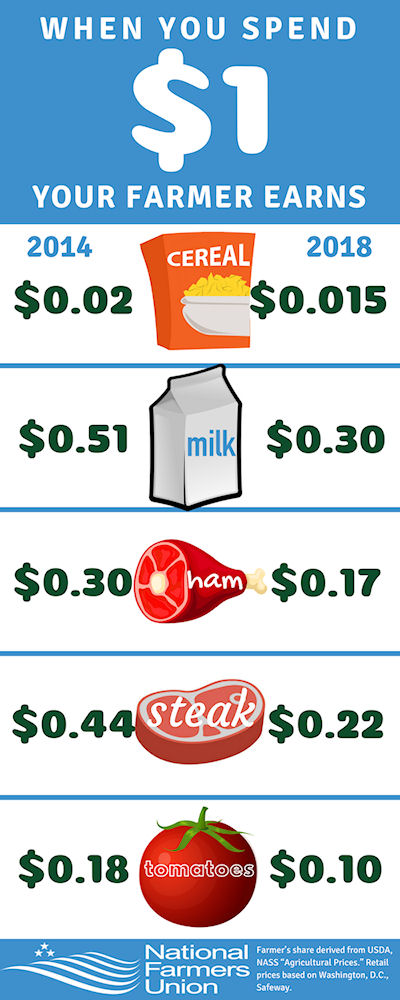Feedstuffs: Farmers’ share of food dollar at all-time low
National Farmers Union’s report shows farmer’s share of food dollar declining as much as 50% for five popular food items.
For every dollar consumers spend on food, the farmer receives just 14.8 cents, according to the U.S. Department of Agriculture. This amount represents a 5% decrease from the previous year’s data and the lowest “farm share” since USDA began reporting the figures in 1993.
As retail grocery prices have increased gradually over time, the share of the average food dollar that America’s farm and ranch families receive has dropped. “Through the mid-1970s, farmers received about one-third of consumer retail food expenditures for food eaten at home and away from home, on average. Since then, that figure has decreased steadily and is now about 14.8%, according to the agriculture department’s revised ‘Food Dollar Series,’” said John Newton, director of market intelligence for the American Farm Bureau Federation.
National Farmers Union (NFU) president Roger Johnson noted that this new low speaks to the state of the farm economy, corporate control of the food system and the importance of prioritizing family farm agriculture in national policy-making.
“This figure strikes a chord with family farmers and ranchers who are dealing with the sharpest decline in net farm income since the Great Depression,” Johnson said. “The prices that farmers have been receiving for their products aren’t paying the bills, and too many are being forced to give up farming. Our nation needs a dramatic, progressive movement towards ensuring family farmers can receive a fair price from the marketplace. Otherwise, we’re going to continue to lose too many of the family farmers and ranchers who feed, fuel and clothe our country, steward our nation’s land and power our rural communities and economies.”
NFU reports monthly on the “Farmer’s Share of the Retail Food Dollar,” which tracks USDA’s farm share for 15 popular food items. The latest NFU report showed that beef producers receive just $2.01 for 1 lb. of beef that costs $8.99 at the supermarket. Wheat farmers average a meager 12 cents on a loaf of bread that retails for $3.49, and dairy producers receive only $1.34 from a $4.49 gal. of fat-free milk.
The Farm Bureau released its “Spring Picnic Marketbasket Survey” at the end of March. The informal quarterly survey showed that the total cost of 16 food items that can be used to prepare one or more meals was $51.05, up $1.02 (2%) compared to a year ago.
Johnson noted that the farmer’s share does not always correlate with food prices and that the disconnect between the two should not confuse consumers.
“While the farmer-to-consumer divide is shrinking in many places due to new markets, it is ever-widening with the country as a whole,” he said. “Most consumers do not fully realize the volatility and risk associated with farming or the economic despair many family farmers are enduring right now. However, when you consider that what you’re paying at the grocery store continues to drop and you see the ‘Farmer’s Share’ continue to drop, you can imagine that it’s hard to earn a decent living in agriculture right now.”
The NFU “Farmer’s Share” figures in April 2014 versus April 2018 show a decline by up to 50% for five popular food items, including:
- Beef producers earned just 22 cents of each retail food dollar in April 2018 compared to 44 cents in April 2014.
- Wheat farmers’ share dropped by 25% from 2014 to 2018.
- Dairy farmers received just 30 cents on the retail food dollar in April 2018 compared to 51 cents in April 2014.


[…] The National Farmer’s Union currently reports farm share of the consumer dollar at an all-time… […]